As round 14 of the Candidates tournament unfolded, I had the feeling of watching an anti-climactic post-exam bender. Ian Nepomniachtchi had already passed with distinction, wrapping up tournament victory with a round to spare. The Russian plays energetic chess, but part of his success in Yekaterinburg was surely attributable to tempering his impulses throughout the event. In the final round he knocked out a few brain cells with his exuberant attack against Ding Liren. It was soundly refuted, but that hardly mattered.
Nepomniachtchi’s instinctive aggression promises a thrilling clash of styles in the World Championship match against Magnus Carlsen, which is scheduled to commence in November 2021. His main pursuer had been Anish Giri, whose commendable performance in the second half included a win against Fabiano Caruana, Carlsen’s previous challenger. But the die was cast when Giri foundered against Alexander Grischuk in the penultimate round. Obviously deflated, and with no remaining chance of victory, he lost a toothless game against bottom seed Kirill Alekseenko in the final round.
Barring the final hiccup, Nepomniachtchi played superbly, particularly in seizing his chances against the bottom markers. Against Wang Hao, he worked relentlessly to create winning chances in an arid position. If Wang’s resignation was slightly premature, his disconsolate state was explained after the event when he announced his retirement from professional play, citing health problems. By contrast, Nepomniachtchi’s win against Alekseenko (below) has an effortless air, which speaks of a player in blistering form.
Ian Nepomniachtchi–Kirill Alekseenko
Candidates, Yekaterinburg, April 2021
1 c4 Nf6 2 g3 e6 3 Bg2 d5 4 Nf3 dxc4 5 Qa4+ Nbd7 6 Qxc4 a6 7 Qc2 c5 8 Nc3! The automatic 8 O-O allows Black to prepare Bc8-b7 with 8…b5, as the discovered attack 9 Ne5 yields little after 9…Nd5. White’s move 8 Nc3 is more precise, as now 8…b5 9 Ne5 Nd5 10 Nxd5 Nxe5 11 Nf6+! wins rook for knight. 8…Be7 9 O-O O-O 10 d4 cxd4 11 Nxd4 Qc7 12 Rd1 Rd8 13 Be3 The clean pawn structure looks innocuous enough, but on closer inspection Black has severe difficulties in developing his pieces, especially the Bc8. The b7-pawn is pinned, while Ra8-b8 and b7-b5 only invites Nd4-c6. Moving the Nd7 (to prepare Bd7) suggests itself, but where to? Placing it on e5 allows a pin with Be3-f4, while 13…Nd7-c5 permits 14 Na4!?, since Bd7 15 Nxc5 Qxc5 16 Qxc5 Bxc5 17 Nxe6! wins a pawn. On f8, the knight is passive while on b6, as in the game, it soon becomes vulnerable to tactics from the bishop on e3. 13…Nb6 14 Rac1 e5 As the game shows, this critically weakens the light squares, particularly d5. But there was nothing better, e.g. 14…Bd7 15 Qb3! threatens Nc3-d5 or Nd4xe6, and Black’s position would collapse after 15…Nc4 16 Nb1! Rac8 17 Bxb7. 15 Nf5 Bxf5 15…Bf8 16 Qb3! Bxf5 17 Bxb6 Rxd1+ 18 Rxd1 Qe7 and now simply 19 Be3 Rb8 20 Qb6 looks likely to win a pawn. 16 Qxf5 Nc4 17 Bg5 Rxd1+ 18 Nxd1 Rd8 19 Bxf6 Bxf6 (see diagram) 20 Be4! Very awkward for Black, as 20…g6 drops the bishop on f6. Note that 20 b3? Ne3!! would turn the tables completely. 20…Qa5 21 Nc3 Kf8 22 Nd5! Clever. Now 22…Rxd5 23 Bxd5 Qxd5 24 Qc8+ picks up the knight on c4. 22…b5 23 Qxh7 Rxd5 24 Bxd5 Qd2 25 Rxc4 bxc4 26 e4 This mighty bishop on d5 enables an easy harvest of pawns in the coming moves. 26…Qxb2 27 Qh8+ Ke7 28 Qc8 Qb6 29 Qxc4 Qb5 30 Qc7+ Qd7 31 Qc5+ 31…Qd6 32 Qa7+ Qd7 33 Qxa6 leaves White two pawns up with complete control, so Black resigns
Got something to add? Join the discussion and comment below.
Get 10 issues for just $10
Subscribe to The Spectator Australia today for the next 10 magazine issues, plus full online access, for just $10.
You might disagree with half of it, but you’ll enjoy reading all of it. Try your first month for free, then just $2 a week for the remainder of your first year.

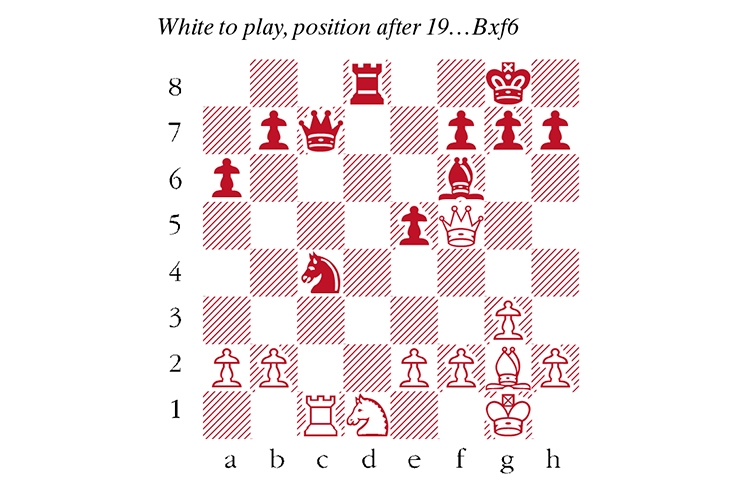
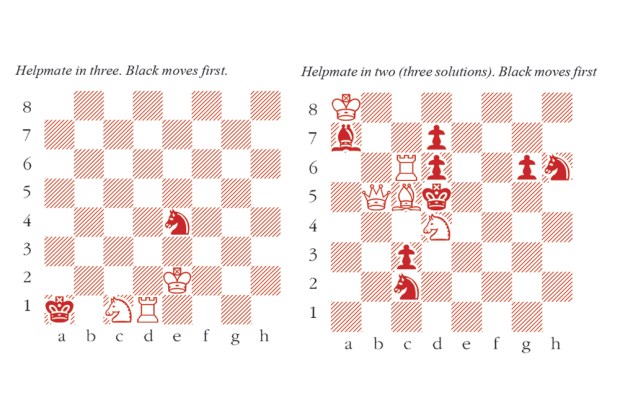
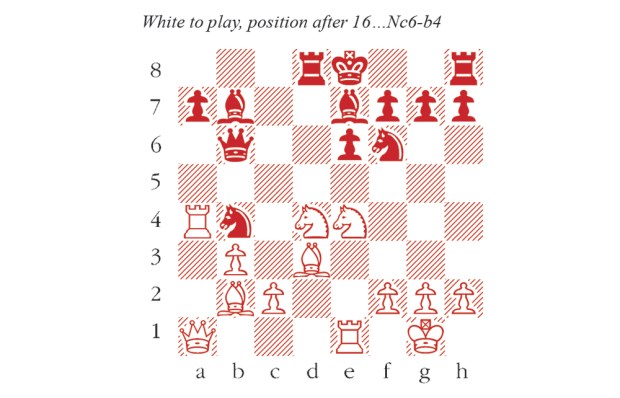
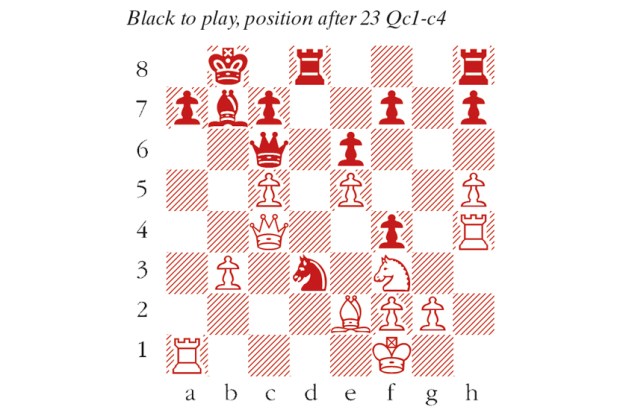
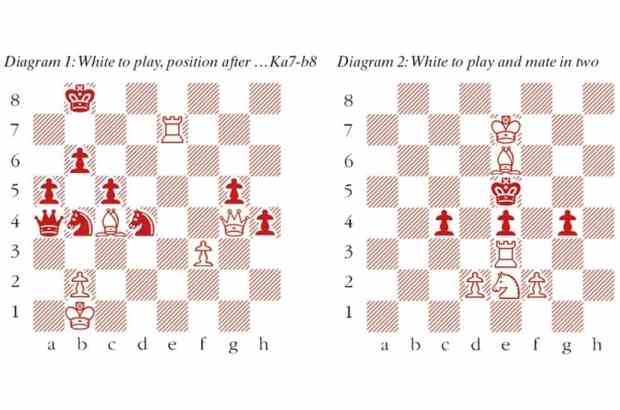
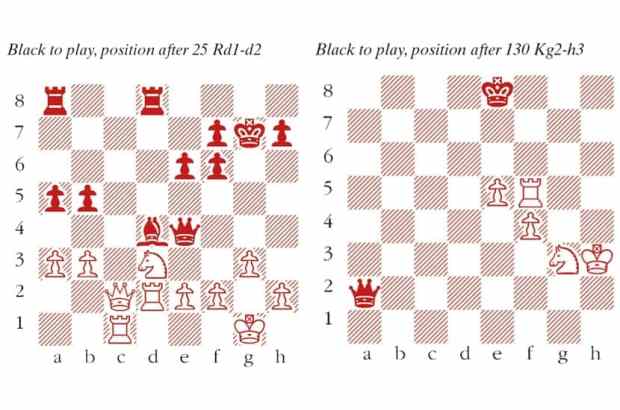
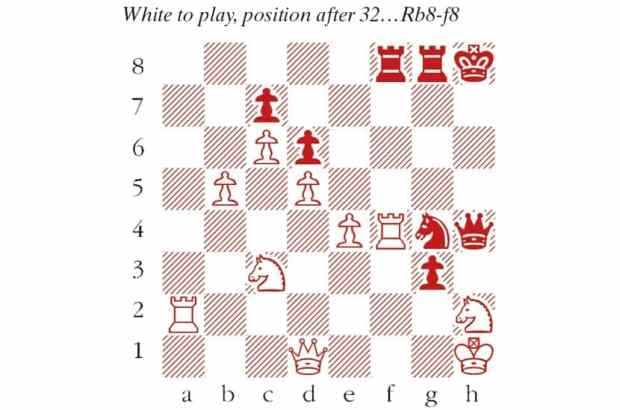






Comments
Don't miss out
Join the conversation with other Spectator Australia readers. Subscribe to leave a comment.
SUBSCRIBEAlready a subscriber? Log in